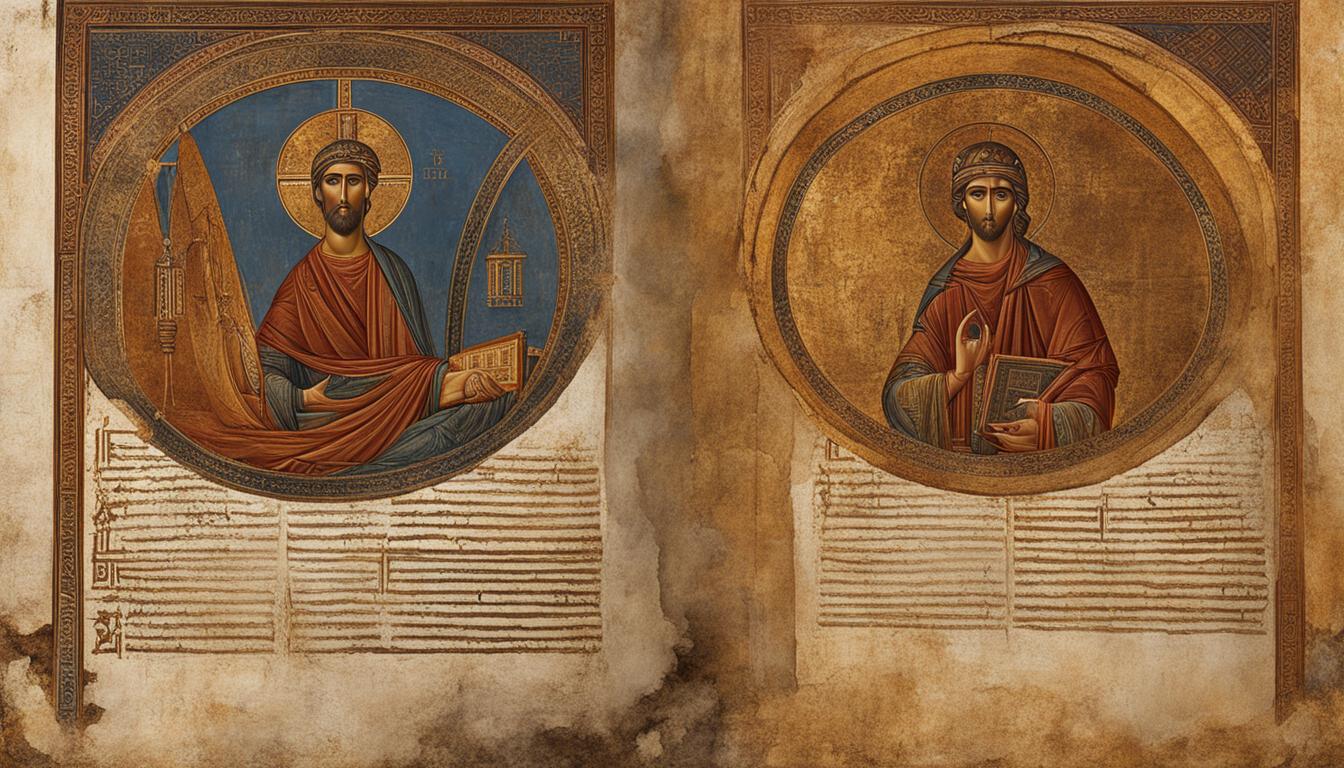The Aramaic Peshitta and the Greek New Testament are two significant texts that have greatly influenced Christian theology. While the Aramaic Peshitta is a translation of the New Testament into Aramaic, the Greek New Testament is the original text written in Greek. Exploring the differences between these texts is essential to understanding their origins, interpretations, and impact on biblical studies.
Key Takeaways:
- The Aramaic Peshitta is a translation of the New Testament into Aramaic, while the Greek New Testament is the original text written in Greek.
- The Aramaic Peshitta originated from Syriac-speaking Christian communities in the Middle East, while the Greek New Testament manuscripts are the original sources for the New Testament.
- There are variations between the Aramaic Peshitta and the Greek New Testament due to the process of translation and the influence of the Greek language and culture.
- The interpretive differences between these texts have implications for Christian theology, as they can lead to different theological interpretations and shed light on the cultural and linguistic nuances of the biblical texts.
- Studying both the Aramaic Peshitta and the Greek New Testament contributes to a comprehensive understanding of the New Testament and the rich heritage of Christianity.
Origins and Manuscripts of the Aramaic Peshitta
The Aramaic Peshitta is a significant translation of the New Testament into Aramaic, the language spoken by Jesus and his disciples. Its manuscripts date back to the 5th to 8th centuries and have been key sources for biblical studies. The origins of the Aramaic Peshitta can be traced to the Syriac-speaking Christian communities in the Middle East, where it played a crucial role in preserving the teachings of Jesus in a language familiar to the local population.
The Aramaic Peshitta manuscripts hold great importance for scholars studying the Aramaic origins of the New Testament. They are highly valued for their accuracy and authenticity, providing a unique perspective on the teachings and life of Jesus. These manuscripts serve as a valuable resource for understanding the linguistic and cultural context in which the New Testament was written, shedding light on the early Christian communities and their beliefs.
Aramaic Peshitta Manuscripts
| Manuscript | Date | Location |
|---|---|---|
| Codex Ambrosianus | 5th Century | Ambrosian Library, Milan |
| Codex Urmensis | 5th Century | University Library, Urmia, Iran |
| Codex Parisiensis | 6th Century | Bibliothèque nationale de France, Paris |
| Codex Ambrosianus | 7th Century | Ambrosian Library, Milan |
These manuscripts, among others, provide invaluable insights into the early development of Christianity and the transmission of the New Testament texts. The Aramaic Peshitta continues to be a vital resource for scholars and believers alike, enriching our understanding of the New Testament and its historical, cultural, and linguistic context.
Greek New Testament Manuscripts and Translation Variations
The Greek New Testament is the original source for the teachings of Jesus and the apostles, written in the Greek language. The manuscripts of the Greek New Testament are of utmost importance for biblical scholars, serving as the basis for constructing authentic translations and interpretations of the scriptures. These manuscripts have been carefully preserved and studied, providing valuable insights into the early Christian texts.
When comparing the Aramaic Peshitta and the Greek New Testament, it is important to note that there are variations between the two translations. The process of translating from Aramaic to Greek can result in interpretive differences, as different words and phrases may be chosen to convey the same concepts. These variations provide scholars with a deeper understanding of the cultural and linguistic nuances of the biblical texts.
Translation Variations in the Scriptures
The translation variations between the Aramaic Peshitta and the Greek New Testament can be seen in various passages of the scriptures. The choice of words, phrases, or even the absence or addition of certain elements can lead to different theological interpretations. For example, a particular passage may emphasize different aspects of Jesus’ teachings or convey a slightly different message in the Aramaic and Greek translations.
| Translation Variation | Aramaic Peshitta | Greek New Testament |
|---|---|---|
| John 1:1 | “In the beginning was the Word, and the Word was with God, and the Word was divine.” | “In the beginning was the Word, and the Word was with God, and the Word was God.” |
| Matthew 16:18 | “And I also say to you that you are Peter, and on this rock, I will build my church.” | “And I tell you, you are Peter, and on this rock, I will build my church.” |
These variations highlight the complexities of translation and the importance of studying multiple versions of the scriptures to gain a comprehensive understanding of the original meanings intended by the authors.

The Greek language and culture have also had a significant influence on the New Testament. The use of Greek in the original texts allowed for the expression of theological concepts and ideas in a way that was familiar to the wider Greco-Roman world. The influence of Greek can be seen in the philosophical and rhetorical style of the New Testament, as well as the adoption of certain Greek terms and expressions.
In conclusion, the Greek New Testament manuscripts form the foundation for understanding the teachings of Jesus and the apostles, while the Aramaic Peshitta provides valuable insights into the language and culture of the early Christian communities. The variations between these translations highlight the complexities of interpretation and the need for careful study and analysis. By examining the manuscripts and translation variations, scholars can gain a deeper appreciation for the rich heritage of Christianity.
Peshitta and Greek New Testament Variations: Exploring Differences in Biblical Texts
The Aramaic Peshitta and the Greek New Testament, both significant texts in Christian theology, exhibit variations that contribute to nuanced interpretations and understanding of biblical texts. The translation process from Aramaic to Greek can lead to differences in word choices, phrases, and even the presence or absence of certain elements, resulting in distinct theological implications. These variations have sparked scholarly discourse and analysis, shedding light on the cultural and linguistic aspects of the New Testament.
Interpretive Differences and Theological Implications
The interpretive differences between the Aramaic Peshitta and the Greek New Testament present unique theological perspectives. Certain passages may have differing words or phrases, prompting a deep exploration of the intended meaning. Scholars and theologians meticulously examine these variants to unravel the original intent of the authors and the cultural context in which the texts were written. By delving into these discrepancies, we gain a deeper understanding of the diverse theological interpretations and traditions that have emerged throughout history.
The variations between the Peshitta and the Greek New Testament enrich our understanding of Christian theology by highlighting the complexity of biblical texts. These variations encourage scholars and believers to engage in critical analysis, fostering a deeper appreciation for the diverse perspectives and the evolution of Christian thought. It is through the diligent study of these variations that we gain valuable insights into the development of Christian theology and the enduring impact of the New Testament on religious discourse.
| Comparison of Peshitta and Greek New Testament Variations | Aramaic Peshitta | Greek New Testament |
|---|---|---|
| Language | Aramaic | Greek |
| Origins | Translation of the New Testament into Aramaic by Syriac-speaking Christian communities | Original text written in Greek |
| Manuscripts | 5th to 8th century | Original sources preserved from the ancient world |
| Interpretive Differences | Choice of words, phrases, and the presence or absence of certain elements | Conveys Greek language and culture, shaping theological concepts and expressions |
Note: The table showcases a brief comparison of the Aramaic Peshitta and the Greek New Testament, highlighting key aspects such as language, origins, manuscripts, and interpretive differences. This comparison serves as a starting point for further exploration and analysis of the variations between these two important texts.
Conclusion
The difference between the Aramaic Peshitta and the Greek New Testament is significant in terms of their origins, interpretations, and impact on Christian theology. The Aramaic Peshitta, as a translation of the New Testament into Aramaic, provides valuable insights into the language and culture of the early Christian communities. On the other hand, the Greek New Testament serves as the original source for understanding the teachings of Jesus and the apostles, making it foundational in biblical studies.
While the Aramaic Peshitta manuscripts date back to the 5th to 8th centuries and played a crucial role in preserving the teachings of Jesus in the language spoken by the people of the region, the Greek New Testament manuscripts are the primary sources used by scholars to construct accurate translations and interpretations of the scriptures. These variations between the Aramaic Peshitta and the Greek New Testament, resulting from the translation process, can have interpretive differences that impact theological understandings.
By studying the differences between the Aramaic Peshitta and the Greek New Testament, scholars and believers gain a deeper appreciation for the rich heritage of Christianity. These texts provide invaluable resources for exploring the original meanings intended by the authors and understanding the cultural and linguistic nuances of the biblical texts. Together, they contribute to a comprehensive understanding of the New Testament, enhancing biblical studies and enriching Christian theological perspectives.
FAQ
What is the difference between the Aramaic Peshitta and the Greek New Testament?
The Aramaic Peshitta is a translation of the New Testament into Aramaic, while the Greek New Testament is the original text written in Greek.
What is the importance of the Aramaic Peshitta in biblical studies?
The Aramaic Peshitta originated from the Syriac-speaking Christian communities in the Middle East and played a significant role in preserving the teachings of Jesus in the language spoken by the people of the region.
What are the origins and manuscripts of the Aramaic Peshitta?
The manuscripts of the Aramaic Peshitta date back to the 5th to 8th centuries and are highly valued for their accuracy and authenticity. They provide insight into the language and culture of the early Christian communities.
What are the Greek New Testament manuscripts and their variations?
The Greek New Testament manuscripts, such as the Byzantine Majority Text and the Critical Text, are the original sources for the New Testament. There are variations between the Aramaic Peshitta and the Greek New Testament due to the process of translation and the influence of the Greek language and culture.
How do the differences between the Aramaic Peshitta and the Greek New Testament impact Christian theology?
The interpretive differences between these texts can lead to different theological interpretations in certain passages. Scholars and theologians study these variations to gain a deeper understanding of the original meanings intended by the authors and to explore the cultural and linguistic nuances of the biblical texts.
 Skip to main content
Skip to main content


